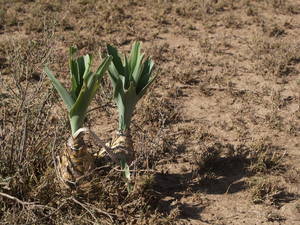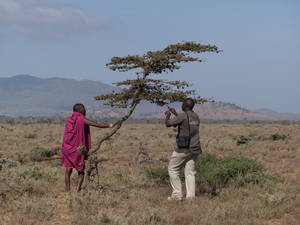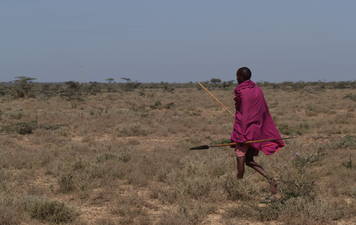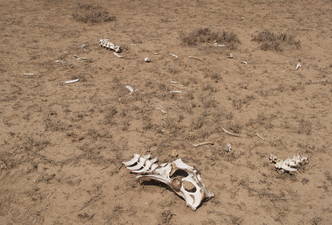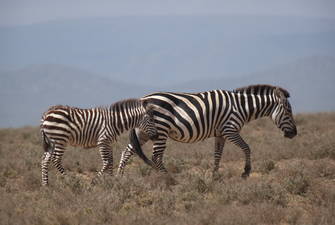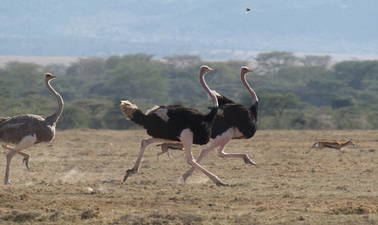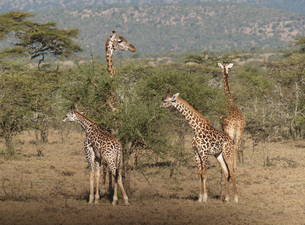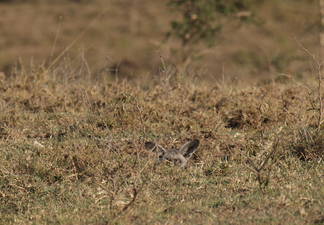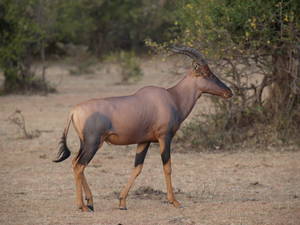Loita Plains, Maji Moto
and Siana Conservation Area
Monday 14th March
While Duncan and Demetrios packed up the camp, Kassim and a local Maasai
guide took us on a walk, across a kind of dry wadi and then over part of
the Loita plains. Kassim did the actual guiding; I think the Maasai was
there with his spear in case any lions turned up. Nothing so exciting
happened, but we saw gazelle, zebra, wildebeest and impala, as well as
Maasai herding cattle, and I got to look for the different species of
ants on whistling thorn acacias.
The vehicle picked us up when we reached the road and we drove to the
Maji Moto tourist campsite, which is run by a Maasai Community Based
Organisation. From there Maasai guides Jonathan and Lisa took us to
visit the Enkiteng Lepa school, run by a feisty woman Hellen.
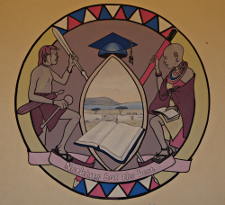
"Nothing but the best"
was the best looking school
of the three we visited on the trip, with clean, spacious classrooms
and a low student-teacher ratio — the school motto seemed more
than aspirational. (I was only half-joking when I suggested it was
probably better than the school my nephews went to in Oxford.) But we
didn't get to see the nearby government school, which would have been
an interesting comparison.
Funding for the school building had come from the Polish government and an
American NGO, in response to a grant application written by a nineteen
year old from the Polish Embassy (whose skirt hangs in the widows'
village as a kind of memorial) — a pretty impressive achievement.
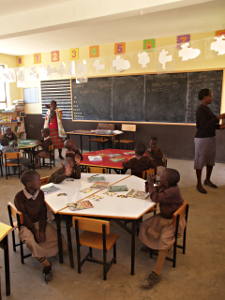
Enkiteng Lepa classroom
Hellen explained that they have to bring in teachers from outside and
that that was the biggest recurrent expense, over a million shillings
(about $12,000) a year. As a private school they don't get government
funding for teachers, but they get the freedom to choose teachers and
can allow the students to wear traditional clothing three days a week.
I'm not sure how they manage to fund this, and the other costs like
providing lunches for the pupils, but the desks were labelled as
IntoAfrica donations and Hellen's spiel extracted a decent sum from us.
So far the school only has four grades and sixty pupils, but it's steadily
expanding as the existing students progress. Maybe three quarters of the
pupils are girls, and the school doubles as a refuge for girls running
away from genital cutting. (Their dormitory had some serious security!)
I'm not sure how well this is going to work when it comes to preserving
traditional Maasai culture, however. How many of the girls being educated
here will be content to build dung houses, herd goats, and milk cows?
Will students stay in the community at all if they end up as doctors
and lawyers? But a Maasai school should give both the students and
community more control over how this works.
The visit offered some fascinating insights into Kenyan education, anyway.
Interestingly, everyone learns and uses Swahili, but instruction is
in English from pretty much the beginning — note the "TAKE AWAY"
on the blackboard in the photo.
This web page has some information about the school.
We had lunch back at the camp and visited a nearby widows village,
where Camilla bought some jewellry as a kind of donation.
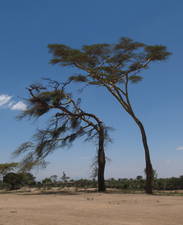
random trees |
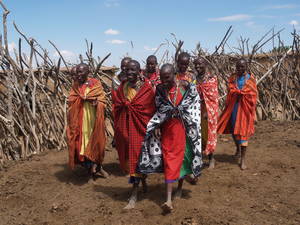
Maasai widows' dance |
We did a game drive in the Siana Conservation Area on our way to the
Masai Mara National Reserve ("the Mara").
Our "tented lodge" was at the end of a bumpy road some distance from
the dingy looking "town" around the park gate, but it turned out to be
very comfortable, among the most comfortable of the trip. We were the
only guests.
After dinner we were supposed to go on a night drive, but about five
minutes into that a fuse blew on the lighter socket which provided
power for the spotlight. So we had to abandon the expedition, which
was a shame.
Next: Masai Mara morning
Previous: into Maasai country
Up: Kenya + Tanzania
